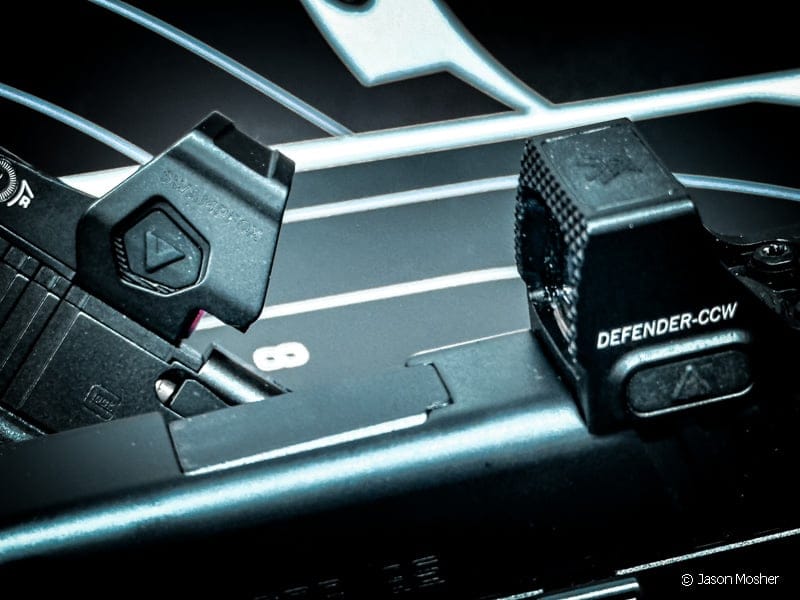Searching for a micro-reflex sight is somewhat frustrating with so many companies producing them. If you don’t know what you’re looking for, you could end up with a cheap red dot that won’t last through the week. You could also pay an arm, two legs, and one ear for a name-brand, high-end optic. But don’t worry; there are some great quality optics out there that sell for a reasonable price.

Further, when picking out a micro red dot for a handgun, there are several things to consider. Brightness settings, auto shut-off settings, and Shake Awake technologies are starting to be standard features, but the battery life span, battery location, and other power-saving features should be taken into account when comparing the price.
Today, we’ll cover two of these affordable yet reliable red dots: the Vortex CCW Defender and the Swampfox Sentinel II. Let’s get into it.
Vortex Defender-CCW
When Vortex released the Defender-CCW, it was a huge improvement over the Viper reflex sight system. The Defender-CCW is housed in a compact frame with a somewhat square-faced look to it. Another feature Vortex gave the Defender is an aggressive texture to the front of the optic. This was to provide a better grip when racking the slide of the gun, but it also just looks cool.
The Defender-CCW utilizes the ever-popular Sheild RMS footprint but works with the RMSc footprint as well.

There are two main features I like about the Defender-CCW. First, the battery location is perfect.
Instead of placing it underneath the optic like most companies do, they placed it on top, making it easy to change the battery when needed. A threaded cap can be unscrewed from the top, just behind the glass to expose the battery. This means you don’t have to remove the optic from the gun to change the battery. This is a huge plus, as I’ve always found it annoying to remove the entire optic and re-zero it every time you have to change the battery as required by other popular optic models. I know, the batteries last forever, but I just don’t like taking them off for a battery change.
Second, the Defender-CCW has a notched area at the rear of the sight and utilizes an auto-on shake-awake feature, making it easier to acquire your target when co-witnessing with your irons. I have the Defender mounted on an IWI Masada S and I can see both sights clearly. Again, that’s a huge plus.
Swampfox Sentinel II Red Dot
I opted to install the Swampfox Sentinel II on my Glock 45 using a plate adaptor for the Shield RMSc footprint. I chose the G45 as the host weapon because the Swampfox is a little larger and beefier than the Defender-CCW, but with good reason. It’s made to withstand harsh and consistent recoil.
Swampfox offers an optional Ironsides Shield metal cover for redundancy in durability. Made of 7075 T6 aluminum, the Sentinel is already a rugged optic. But add the Ironsides Shield and you turn it into a tank.

You can also use the optic without the additional metal cover and it’s a perfect size for CCW guns. It has 10 illumination settings and runs on an under-mounted 2032 battery. I’m not a huge fan of under-mounted batteries, but that’s just me. It is IPX7 waterproof, which is another win in my book. Plus, the Swampfox includes a built-in auto on/off feature, which is one of the most important things I watch for when purchasing optics.

Is there a winner here?
Deciding which one of these optics is better would be hard to do. One of the biggest differences between the two is the price. The Defender-CCW retails for $349.99 on their website and the Sentinel II is listed at $269 from Swampfox. Vortex doesn’t give a waterproof/resistant rating but instead says it resists moisture, dust, and debris in all weather environments. The Defender-CCW is also backed by Vortex’s trusted VIP lifetime warranty.
Both optics are durable and made to withstand the abuse from the elements and clumsy people like me. Swampfox added a rare feature to their red dot by providing a rear Night Fision sight guide with the optic. This rear sight can be attached in front of the glass to provide a rear optic for those guns that have non-compatible sights for optics. Both sights offer some of the same features I look for in red dots.
I do like the Ironsides Sheild, which retails for $39 on their website. Both optics have one button on each side that brightens or dims the red dot. On the range, I can’t say either sight did better than the other. They were both easy to zero and easy to use in the daylight. I try to give a “winner” when comparing two optics. In this case, however, I’m struggling to choose which one I like the most. The best I can do in this case, however, is say pick the one that appeals to you the most. Either way, you can’t go wrong.


